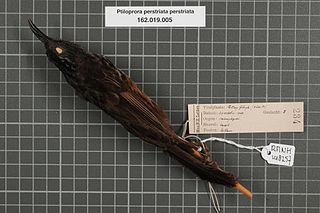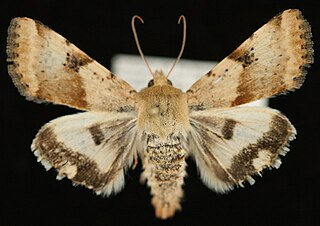
Helicoverpa zea, commonly known as the corn earworm, is a species in the family Noctuidae. The larva of the moth Helicoverpa zea is a major agricultural pest. Since it is polyphagous during the larval stage, the species has been given many different common names, including the cotton bollworm and the tomato fruitworm. It also consumes a wide variety of other crops.

Heliothis is a genus of moths in the family Noctuidae. It was first described by Ferdinand Ochsenheimer in 1816. Some of the species have larvae which are agricultural pests on crop species such as tobacco, cotton, soybean and pigeon pea. Some species originally in this genus have been moved to other genera, see Chloridea and Helicoverpa.

The grey-streaked honeyeater, also known as the black-backed honeyeater, is a species of bird in the family Meliphagidae. It is found in the New Guinea Highlands. Its natural habitat is subtropical or tropical moist montane forests.

Methomyl is a carbamate insecticide introduced in 1966. It is highly toxic to humans, livestock, pets, and wildlife. The EU and UK imposed a pesticide residue limit of 20 µg/kg for apples and oranges.

Heliothis peltigera, also known as the bordered straw, is a species of moth of the family Noctuidae.

Nudiviruses are a family of animal viruses that constitute the family Nudiviridae. Insects and marine crustaceans serve as natural hosts. There are 11 species in this family, assigned to 4 genera. Diseases associated with this family include: death in larvae, chronic disease in adults.

Chloridea virescens, commonly known as the tobacco budworm, is a moth of the family Noctuidae found throughout the eastern and southwestern United States along with parts of Central America and South America.

Masalia was a genus of moths of the family Noctuidae. It is now considered to be a subgenus of Heliothis.

Heliothis phloxiphaga is a species of moth of the family Noctuidae. It is found in the United States and southern Canada. It feeds on a variety of plants, and the caterpillars are considered pests to certain trees, including Ulmus, Malus, and Prunus. Adults are on-wing during the summer.
Heliothis albida is a moth of the family Noctuidae. It is found in North Africa, the Arabian Peninsula, the Levant and the deserts of Iran.

Apamea perstriata is a moth of the family Noctuidae.

The shoulder-striped clover is a species of moth of the family Noctuidae. It is found in most of Europe, Ukraine, southern Russia and southern Siberia, Transbaikalia, Turkey, central Asia, China, Japan, the Korean Peninsula, Mongolia, northern India, Pakistan, the Russian Far East.

Heliothis ononis, the flax bollworm, is a moth of the family Noctuidae. The species was first described by Michael Denis and Ignaz Schiffermüller in 1775. It is found in China, Kazakhstan, central Asia, northern Mongolia (Khangai), the Russian Far East, the Korean Peninsula, southern European part of Russia, southern and central Europe, southern and eastern Siberia and Turkey. In North America it is found from south-central Manitoba west to British Columbia, north to the Northwest Territories and Yukon and Alaska and south to Colorado.

Heliothis oregonica, the Oregon gem, is a moth of the family Noctuidae. The species was first described by Henry Edwards in 1875. It is found in North America from the Peace River area of Alberta south and west in the mountains to California and Arizona. There is also a disjunct population in north central Quebec.

Heliothis borealis, the boreal gem, is a moth of the family Noctuidae. The species was first described by George Hampson in 1903. It is found in North America from Quebec west to Alberta, and south in the mountains to south-western Montana.
Heliothis philbyi is a species of moth of the family Noctuidae. It is found in the Middle East, including Saudi Arabia, Iran and Oman.

Chloridea subflexa is a moth of the family Noctuidae first described by Achille Guenée in 1852. It is found from most of the United States, throughout the Antilles, and south to Argentina.

Heliothinae is a small, cosmopolitan subfamily of moths in the family Noctuidae, with about 400 described species worldwide. It includes a number of economically significant agricultural pest species, such as Helicoverpa armigera and Helicoverpa zea.
V-sub x, also known as GD-7, is an organophosphate nerve agent of the V-series, the phosphonate analog of the organophosphate insecticide demeton. EA-5478 is the pinacolyl analogue.
Cytochrome P450, family 9, also known as CYP9, is a cytochrome P450 family found in Insect genome, CYP9 and insect CYP6 family belong to the same clan as mammalian CYP3 and CYP5 families. The first gene identified in this family is the CYP9A1 from the Heliothis virescens, which is involved in thiodicarb insecticide resistance. Subfamily CYP9A in Lepidopteran play important roles in insecticide resistance, can metabolize esfenvalerate efficiently.











